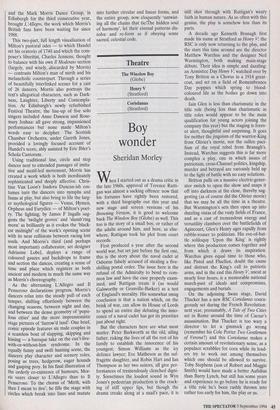Dance
Scottish dancing
Sophie Constanti
Has Edinburgh replaced London as dance capital of Britain? On the basis of quality, as opposed to quantity, Edinburgh has been setting standards of excellence since 1992, thanks to Brian McMaster's inspired dance programming for the city's annual festival. That the two best dance events of 1994 — Miami City Ballet's selec- tion of works from the Balanchine reperto- ry; and the Mark Morris Dance Group in Morris's glorious L'Allegro, ii Penseroso ed il Moderato — should (now predictably) grace Edinburgh and bypass London, only endorses the view that the latter's status is more assumed than deserved. And rather the five events at Edinburgh (even if it means doing without dance for the rest of the year), than London's perpetual drizzle of mediocrity.
Like most other international festivals, Edinburgh prides itself on securing United Kingdom debuts and new productions, and McMaster's record in terms of dance is exemplary. This year, the city hosted the second British visit of Edward Villella's young and wonderfully exuberant Miami City Ballet, and the first performances in this country by New York's more introspec- tive but pivotal Lucinda Childs Dance Company and Montreal's Foundation Jean-Pierre Perreault. In addition, Merce Cunningham's company gave the United Kingdom premiere of his most recent piece of computer-assisted choreography, Enter, and the Mark Morris Dance Group, in Edinburgh for the third consecutive year, brought L'Allegro, the work which Morris's British fans have been waiting for since 1988.
This two-part, full length visualisation of Milton's pastoral odes — to which Handel set his oratorio of 1740 and which the com- poser's librettist, Charles Jennens, thought to balance with his own ll Moderato section (largely, and wisely, vdiscarded by Morris) — contrasts Milton's man of mirth and his melancholic counterpart. Through a series of beautifully interlinked scenes for a cast of 26 dancers, Morris also portrays the text's allegorical characters, such as Dark- ness, Laughter, Liberty and Contempla- tion. At Edinburgh's newly refurbished Festival Theatre, the line-up of five solo singers included Anne Dawson and Rose- mary Joshua: all gave strong, impassioned performances but none made Milton's words easy to decipher. The Scottish Chamber Orchestra, under Gareth Jones, provided a lovingly focused account of Handel's score, ably assisted by Eric Ibler's Schola Cantorum.
Using traditional line, circle and step dances next to extended passages of imita- tive and motif-led movement, Morris has created a work which is both inordinately sophisticated and deeply affective. Chris- tine Van Loon's Isadora Duncan-ish cos- tumes turn the dancers into nymphs and fauns at play, but also bring to life the larg- er mythological figures — Venus, Hymen, Orpheus and Eurydice — of Milton's poet- ry. The lighting, by James F Ingalls sug- gests the 'twilight groves' and `slumb'ring morn' as brilliantly as it evokes the 'black- est midnight' of the work's opening scene with its near collisions between racing lost souls. And Morris's third (and perhaps most important) collaborator, set designer Adrianne Lobel, deploys a range of coloured gauzes and backdrops to frame and section the dances, creating a sense of time and place which registers as both ancient and modern in much the same way as Morris's choreography. As the alternating L'Allegro and Il Penseroso declarations progress, Morris's dancers relax into the steady pull of each temper, shifting effortlessly between the changing seasons, between night and day, and between the dense geometry of 'popu- lous cities' and the more impressionistic stage pictures of `furrow'd land'. One brief, comic episode features six male couples in a seamless bout of slapping, skipping and kissing — a baroque take on the can't-live- with-or-without-him syndrome. In the equally funny and swift hunting scene, the dancers play character and scenery roles, posing as trees, hedgerow, eager hounds and gasping prey. In his final illustration of the orderly co-existence of humours, Mor- ris veers closer to L'Allegro than to Il Penseroso. To the chorus of 'Mirth, with thee I mean to live', he fills the stage with circles which break into lines and mutate into further circular and linear forms, and the entire group, now eloquently 'untwist- ing all the chains that tie/The hidden soul of harmony', let their eternal patterns dis- solve and re-form as if obeying some sacred, celestial code.



























































 Previous page
Previous page